Hamsters are among the most popular small pets. They are beloved not only for their cute appearance but also for their affectionate and playful natures. For many people, deciding that they want a pet hamster is an easy decision. What’s more difficult is deciding which breed you want. There are a total of 5 different hamster species that you can choose from.
While all hamster species are cute, they all have their own unique personalities, physical traits, and origins. Because of this, it’s important that you buy the one that fits you best.
To help you with that, we’re going to take a look at the 5 pet hamster species in a little more detail. I’ll give a short description of each, with a link to a more in-depth overview of them. That way, you can make the most informed decision on which hamster is right for you.
Before we begin, I’d like to note that they’re technically 5 different species, not breeds. However, people often use these words interchangeably.
Prefer video? We’ve got you covered!
The 5 Hamster Breeds
1. Syrian Hamster
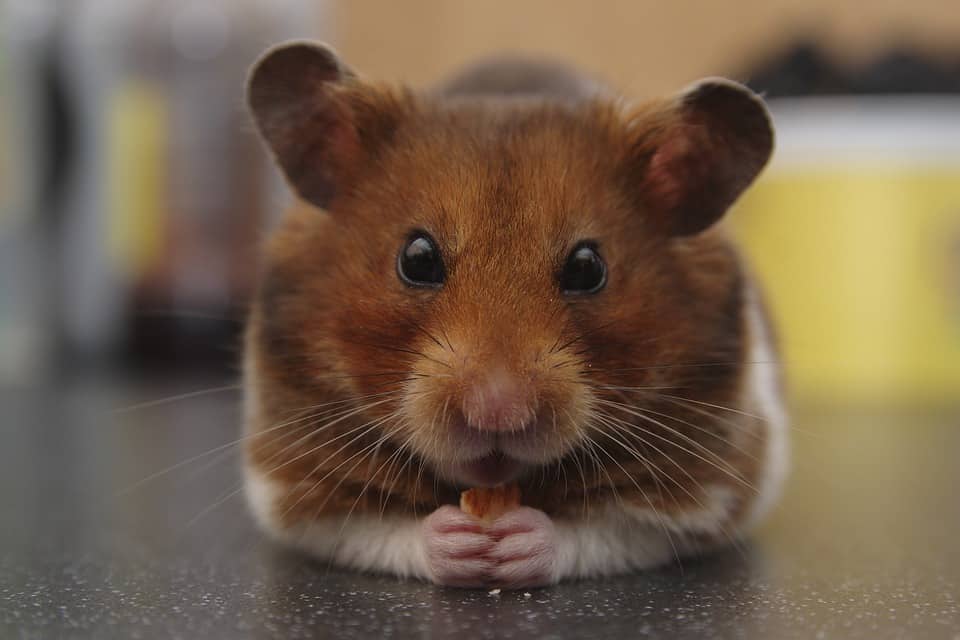
| Size | 6 inches |
| Lifespan | 2 to 3 years |
| Temperament | Affectionate, docile, good-natured, inquisitive, energetic |
| Experience required | Beginner |
When people think of hamsters, they usually think of the Syrian hamster. The Syrian is the biggest species and is also known as the Golden hamster. It’s native to arid regions in Syria and Turkey.
The Syrian is not only the biggest breed, it’s also the most social and affectionate. If you’re looking for a pet that’s not shy, easy to tame, and a lot of fun to play with, the Syrian is a good bet.
An important thing to note is that Syrian hamsters must be kept alone. Never place two Syrians in a cage together because this will lead to fights.
They have a lifespan of 2 to 3 years, grow to a size of about 6 inches, and typically weigh around 5 pounds. They’re most often a golden color but come in a large variety of other colors, including chocolate, black, gray, and cinnamon. In addition, they can have short or long hair and their coats can even be curly or hairless!
All this variation gives pet owners plenty to choose from when buying a Syrian hamster.
This is the ideal first-time hamster-owner pet. They’re docile, affectionate, intelligent, and a lot of fun to play with.
Pros
- As the most affectionate and social breed, they’re more receptive to being handled
- Many different colors, hair lengths, and patterns to choose from
- Good with children
Cons
- Due to their territorial nature, they can’t live in pairs or groups
2. Roborovski Dwarf Hamster
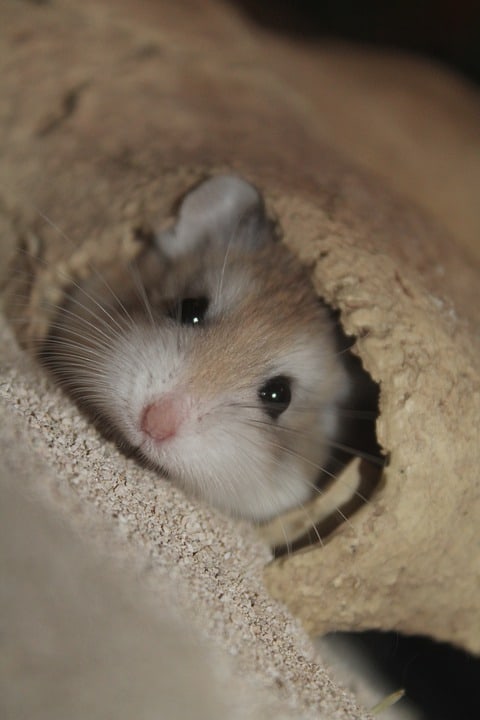
| Size | 2 inches |
| Lifespan | 2 to 4 years |
| Temperament | Shy, not as social as some other hamster breeds |
| Experience required | Intermediate |
The Roborovski dwarf hamster is the most popular dwarf breed. These small, fast rodents are native to the deserts of central Asia. They’re the smallest of all the pet hamster breeds at a length of only 1.8 to 2 inches and a weight of 0.7 to 0.8 ounces.
These little critters are usually sandy in color but can have many other colors and patterns as well. They’re characterized by their long whiskers and the lack of a dorsal stripe, something that the other dwarfs do have.
Roborovskis are not the cuddliest species. They’re more of a pet to watch than one to really play with. However, feeding, caring, and interacting with them can still be a lot of fun as long as you know what you’re getting into. If you’re new to caring for hamsters, getting a Roborovski is not recommended. Their shy nature makes them more suitable for experienced pet owners.
Pros
- Fun to watch
- Very adorable appearance
- Can sometimes be kept in pairs
Cons
- Least social
- Not very receptive to being handled
3. Chinese Hamster
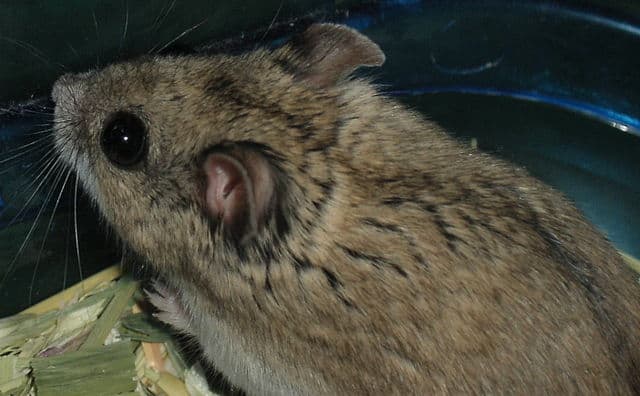
| Size | 3 to 5 inches |
| Lifespan | 2 to 3 years |
| Temperament | Good-natured, shy, territorial |
| Experience required | Beginner |
The Chinese hamster is a small breed that comes from the deserts of Northern Mongolia and China. They’re officially not dwarfs but are often grouped in with them because of their small size. They’re only 3 to 5 inches in length and typically weigh between 1 and 2 ounces.
One of the easiest ways to identify a Chinese hamster is by looking at its tail. Unlike other species, which have short and stubby tails, the Chinese’s tail is actually quite long. It can grow to a size of up to 1.3 inches in length. Other characteristics are their black dorsal stripe and their short, smooth coat which comes in 3 types: normal (brown), dominant spot, and black-eyed white.
Chinese Hamsters are generally affectionate and good-natured but they can also be quite shy. However, they’re also quite an intelligent breed that’s able to learn tricks quite quickly. They’re not prone to biting but will nip if they feel threatened. Like the Syrian, Chinese hamsters can not live in pairs or groups. Their territorial nature will result in fights.
Pros
- Intelligent
- Not likely to nip/bite
- Relatively okay with being handled
Cons
- Quite shy
- Cannot be kept in pairs or groups
4. Winter White Dwarf Hamster
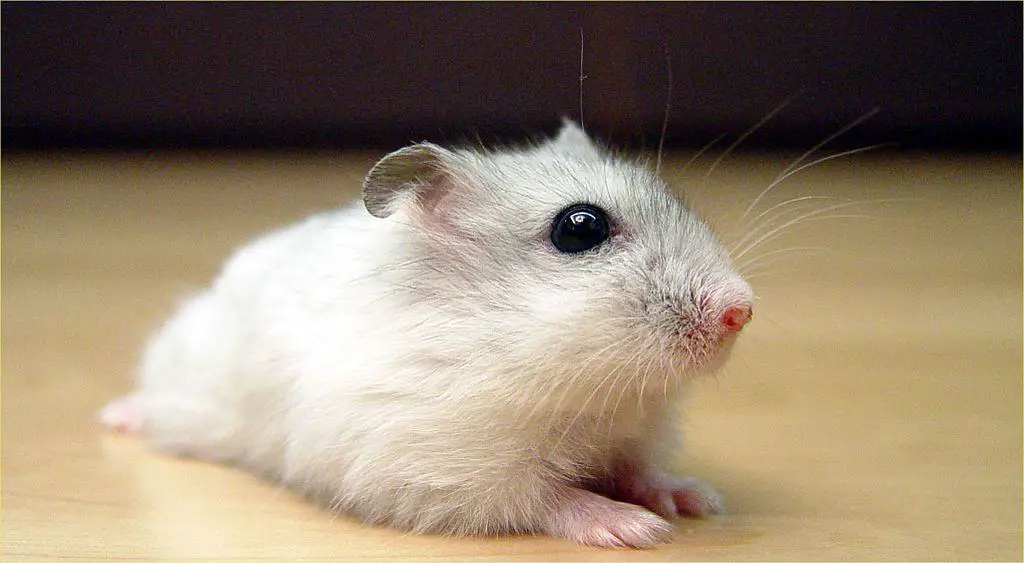
| Size | 3 to 4 inches |
| Lifespan | 1 to 3 years |
| Temperament | Tameable, social, intelligent |
| Experience required | Beginner |
The winter white is a small dwarf hamster native to Siberia, Mongolia, and Kazakhstan. They’re known under many names but are most often called simply Winter Whites or Djungarian hamsters.
They are typically between 3 and 4 inches in length and weigh around 1 to 2 ounces. They have a large, dark dorsal stripe on their back and their fur is smooth and short.
The most interesting characteristic of the winter white dwarf hamster is that its coat changes colors. In the summer it’s grayish while in the winter it turns white. Interestingly enough, it’s possible to breed the Winter White with another species, the Campbell, which can result in them having other colors as well.
Winter whites are tameable, intelligent, docile, and social animals that are quite easy to tame. They are sometimes a little prone to nipping compared to other breeds especially when they feel threatened. These hamsters are capable of sharing their cage with others in some cases.
Pros
- Their coat changes appearances depending on the season
- Quite easy to tame
- Capable of living in groups or pairs in some cases
Cons
- Sometimes more prone to nipping
- Can be very vocal
5. Campbell’s Dwarf Hamster
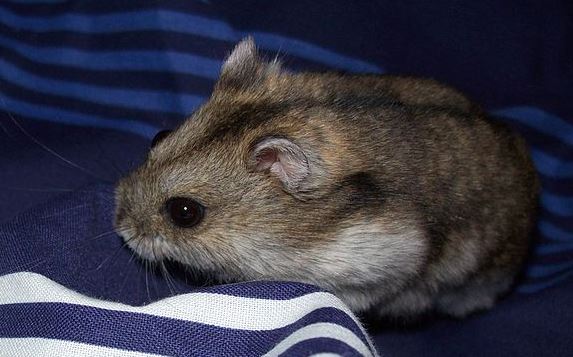
| Size | 2 to 4 inches |
| Lifespan | 2 to 3 years |
| Temperament | Friendly |
| Experience required | Beginner |
The last hamster breed is Campbell’s Dwarf Hamster. This species has a lot in common with the winter white. They have so much in common that they’re capable of producing offspring together and they’re often mistaken for one another. The easiest way to differentiate between a Campbell and a Winter White is by looking at their dorsal stripe and ears. Campbell’s have a narrower dorsal stripe and smaller ears.
Campbell’s hamsters have a short coat that comes in many colors but by far the most common color is gray-brownish. This is the color that they have in nature. These little critters are typically 2 to 4 inches in length when fully grown and weigh 1 to 2 ounces.
Campbell’s are friendly little rodents that have a temperament similar to the Winter White. They’re easy to tame and like their cousins, they’re sometimes able to live in pairs or small groups.
Pros
- Comes in a wide range of colors
- Relatively easy to tame
- Can sometimes live in groups or pairs
Cons
- Can be prone to nipping
- Can be vocal
Final words: Which Hamster Breed is Right For You?
There you have it, the 5 pet hamster species! All the species are unique and because of that, they all have their own pros and cons. It’s up to you to decide which one fits you best.
In my opinion, the Syrian is the best choice for people who want a pet that they plan on playing with and handling a lot. It’s also my go-to recommendation for a pet for children due to their more social nature.
On the other hand, if you’re planning on spending more time observing than actually playing with your new friend, the Roborovski with its introverted nature might be the best fit for you.
As a rule of thumb, the smaller dwarf species are best avoided if you want to handle and cuddle your pet a lot.
- How Long Do American Eskimo Dogs Live? Important Factors and Care Tips - September 29, 2023
- Do American Bulldogs Need Grooming? Essential Tips and Care Guidelines - September 29, 2023
- Do Bengal Cats Enjoy Playing? Essential Tips for Keeping Them Active - September 29, 2023